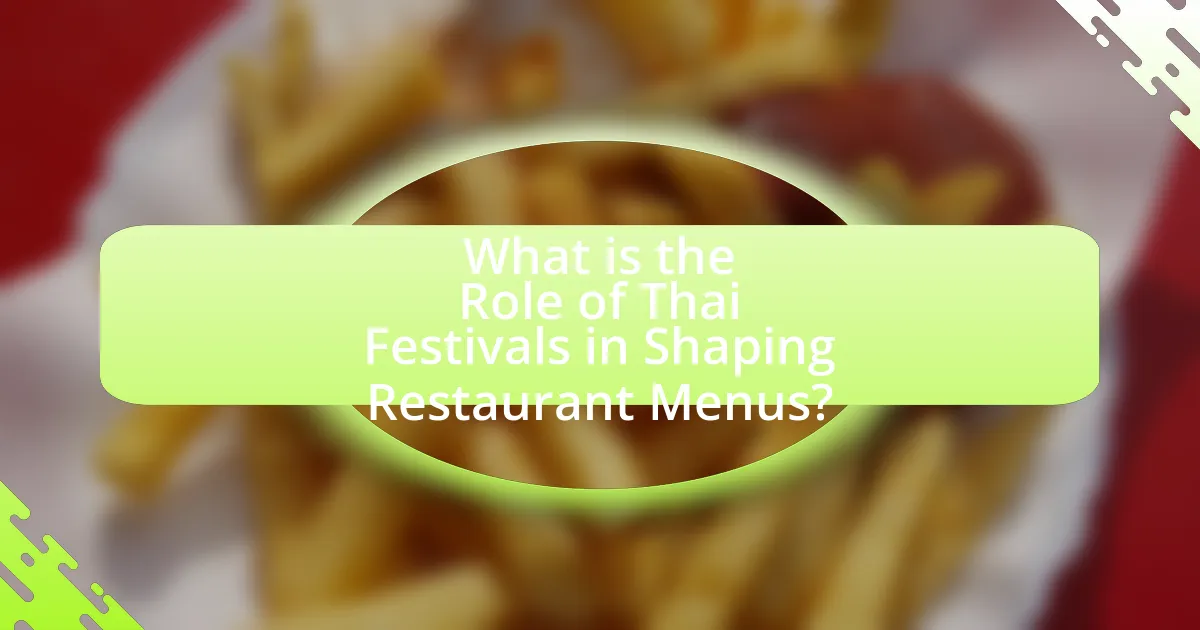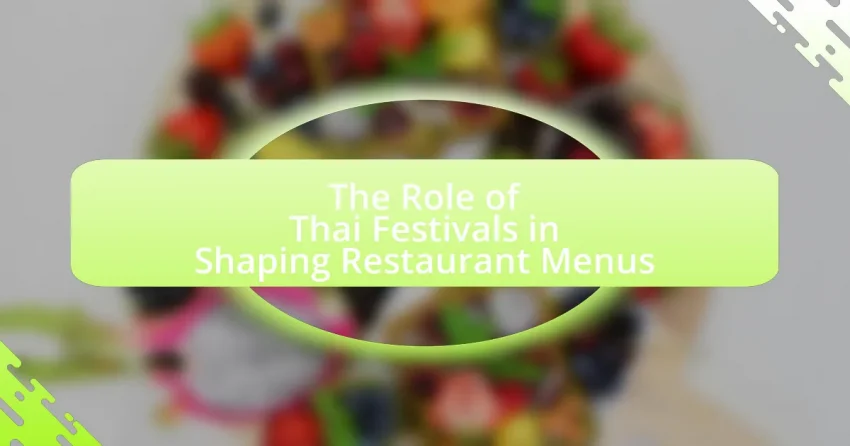The main entity of the article is the influence of Thai festivals on restaurant menus. Thai festivals, such as Songkran and Loy Krathong, significantly shape culinary offerings by promoting seasonal ingredients and traditional dishes that reflect cultural practices. The article explores how these festivals inspire restaurants to create special menus, enhance customer experiences, and preserve culinary heritage. It also discusses the challenges restaurants face in aligning their menus with festival themes, including ingredient availability and customer expectations, while highlighting best practices for effectively integrating festival elements into dining experiences.

What is the Role of Thai Festivals in Shaping Restaurant Menus?
Thai festivals play a significant role in shaping restaurant menus by influencing the seasonal availability of ingredients and inspiring traditional dishes. During festivals such as Songkran and Loy Krathong, restaurants often feature special menus that highlight regional specialties and festive foods, reflecting cultural practices and culinary heritage. For instance, during Songkran, dishes like Khao Chae, a rice dish served with iced water and various accompaniments, become popular, as they are traditionally consumed during the hot season. This alignment with cultural events not only attracts customers seeking authentic experiences but also promotes the use of local and seasonal ingredients, enhancing the overall dining experience.
How do Thai festivals influence culinary traditions?
Thai festivals significantly influence culinary traditions by promoting the preparation and consumption of specific dishes that reflect cultural values and seasonal ingredients. For instance, during Songkran, the Thai New Year, families prepare traditional foods such as Khao Chae, which symbolizes purification and renewal. This festival encourages restaurants to feature these seasonal dishes, thereby shaping their menus to align with cultural practices. Additionally, festivals like Loy Krathong highlight the use of ingredients like rice and flowers, leading to the creation of special dishes that celebrate the occasion. This integration of festival-specific foods into restaurant offerings not only preserves culinary heritage but also attracts customers seeking authentic experiences tied to cultural celebrations.
What specific festivals have the most impact on restaurant menus?
The specific festivals that have the most impact on restaurant menus in Thailand are Songkran, Loy Krathong, and Yi Peng. Songkran, celebrated in April, influences menus with traditional dishes like Khao Chae, a rice dish served with various side dishes, reflecting the festive spirit of water and renewal. Loy Krathong, occurring in November, prompts restaurants to feature dishes like Khanom Krok, a coconut pudding, symbolizing the floating of krathongs on water. Yi Peng, also in November, encourages the inclusion of lantern-themed desserts and dishes that celebrate light and hope. These festivals drive seasonal menu changes, showcasing local ingredients and traditional recipes, thereby enhancing cultural dining experiences.
How do seasonal ingredients from festivals affect menu offerings?
Seasonal ingredients from festivals significantly influence menu offerings by encouraging restaurants to incorporate traditional and locally sourced items that reflect cultural significance. For instance, during the Thai New Year, known as Songkran, restaurants often feature dishes made with fresh fruits like mango and coconut, which are abundant at this time. This practice not only enhances the authenticity of the menu but also attracts customers seeking a genuine festive experience. Additionally, the use of seasonal ingredients aligns with sustainability trends, as it promotes the consumption of locally grown produce, thereby supporting local farmers and reducing carbon footprints.
Why are festivals significant in Thai culture and cuisine?
Festivals are significant in Thai culture and cuisine because they serve as vital expressions of community identity and culinary heritage. These celebrations often involve traditional foods that reflect regional ingredients and cooking methods, showcasing the diversity of Thai gastronomy. For instance, during Songkran, the Thai New Year, families prepare dishes like Khao Chae, which symbolizes the refreshing nature of the season. Additionally, festivals provide opportunities for restaurants to innovate and adapt their menus to include seasonal specialties, thereby enhancing the dining experience and preserving cultural practices. This connection between festivals and cuisine reinforces the importance of food in social gatherings and cultural rituals in Thailand.
What cultural elements are celebrated during Thai festivals?
Thai festivals celebrate various cultural elements, including traditional rituals, religious practices, local customs, and community gatherings. For instance, Songkran, the Thai New Year festival, emphasizes water pouring as a symbol of purification and renewal, while Loy Krathong involves floating decorated baskets on water to honor the goddess of water. These festivals showcase Thailand’s rich heritage through music, dance, food, and vibrant decorations, reflecting the country’s values and beliefs. The celebration of these cultural elements during festivals significantly influences restaurant menus, as many establishments incorporate traditional dishes and festive specialties to attract patrons during these events.
How do these cultural elements translate into restaurant menu items?
Cultural elements from Thai festivals translate into restaurant menu items by inspiring the inclusion of traditional dishes that reflect the themes and ingredients associated with these celebrations. For instance, during Songkran, the Thai New Year, restaurants often feature dishes like Khao Chae, which is rice served in iced water, symbolizing the cooling of the body and spirit during the hot season. Additionally, festivals such as Loy Krathong lead to menu items that incorporate seasonal ingredients like lotus flowers and banana leaves, which are used in the festival’s rituals. This connection between cultural practices and culinary offerings enhances the authenticity of the dining experience and attracts customers seeking traditional flavors tied to specific cultural events.
What are the key characteristics of Thai festival cuisine?
Thai festival cuisine is characterized by its vibrant flavors, diverse ingredients, and communal dining practices. The cuisine often features a balance of sweet, sour, salty, and spicy elements, which are essential in traditional Thai cooking. Dishes commonly include fresh herbs, spices, and seasonal produce, reflecting the local agricultural practices and cultural significance of the festivals. For instance, during the Songkran festival, dishes like Khao Chae (rice in iced water) are popular, showcasing the use of fresh ingredients and the importance of refreshing flavors in the hot season. Additionally, festival cuisine emphasizes sharing and togetherness, with large platters meant for communal enjoyment, reinforcing social bonds during celebrations.
What types of dishes are commonly featured during Thai festivals?
Thai festivals commonly feature dishes such as Pad Thai, Som Tum (green papaya salad), and Khao Niew Mamuang (mango sticky rice). These dishes are integral to celebrations, reflecting regional flavors and traditional cooking methods. For instance, Pad Thai is often served during Songkran, the Thai New Year, symbolizing prosperity and good fortune. Som Tum is popular during various festivals for its refreshing taste and balance of flavors, while Khao Niew Mamuang is a staple dessert during the summer months, particularly during the mango season, celebrated in many festivals.
How do flavors and presentation change during festival seasons?
Flavors and presentation in Thai cuisine significantly change during festival seasons to reflect cultural traditions and seasonal ingredients. During festivals such as Songkran and Loy Krathong, restaurants often incorporate vibrant colors and unique flavor profiles that symbolize prosperity and celebration. For instance, dishes may feature fresh herbs, spices, and seasonal fruits, enhancing both taste and visual appeal. Additionally, traditional presentation styles, such as elaborate garnishing and thematic plating, are emphasized to create a festive atmosphere. This adaptation aligns with the cultural significance of food during these events, where specific flavors and presentations are believed to bring good fortune and joy.
How do restaurants adapt their menus for Thai festivals?
Restaurants adapt their menus for Thai festivals by incorporating traditional dishes and seasonal ingredients that reflect the cultural significance of the celebrations. For instance, during Songkran, the Thai New Year, restaurants often feature dishes like Khao Chae (rice in iced water) and various types of Thai desserts that are popular during this time. Additionally, they may offer special promotions or themed events that highlight these dishes, enhancing the festive atmosphere. This adaptation not only attracts customers seeking authentic festival experiences but also honors the culinary traditions associated with Thai culture, thereby reinforcing the restaurant’s connection to the community and its heritage.
What strategies do restaurants use to incorporate festival themes?
Restaurants incorporate festival themes by designing special menus, creating themed decor, and hosting events that reflect the cultural significance of the festival. For instance, during Songkran, Thai restaurants may offer traditional dishes like Khao Chae and set up water-themed decorations to enhance the festive atmosphere. Additionally, they often engage in promotional activities, such as discounts or special events, to attract customers celebrating the festival. This approach not only honors the cultural heritage but also boosts customer engagement and sales during the festival period.
How do customer preferences influence menu changes during festivals?
Customer preferences significantly influence menu changes during festivals by driving restaurants to adapt their offerings to meet the demand for traditional and festive dishes. During Thai festivals, such as Songkran and Loy Krathong, customers often seek authentic experiences that reflect cultural significance, prompting restaurants to incorporate seasonal ingredients and traditional recipes into their menus. For instance, a study by the Thai Ministry of Tourism and Sports indicated that 70% of diners prefer dishes that resonate with festival themes, leading establishments to create special menus that highlight local flavors and festive specialties. This alignment with customer preferences not only enhances the dining experience but also boosts sales during peak festival periods.
What challenges do restaurants face when aligning menus with festivals?
Restaurants face several challenges when aligning menus with festivals, including ingredient availability, cultural authenticity, and customer expectations. Ingredient availability can be problematic as certain festival-specific items may not be in season or easily sourced, leading to menu inconsistencies. Cultural authenticity is crucial, as restaurants must ensure that the dishes they offer genuinely represent the festival’s traditions, which can be difficult if staff lack knowledge or experience with the cuisine. Additionally, customer expectations can vary widely; diners may anticipate specific flavors or presentations that are difficult to achieve consistently. These challenges highlight the complexities restaurants encounter in creating festival-themed menus that satisfy both operational capabilities and customer desires.
How do supply chain issues affect ingredient availability during festivals?
Supply chain issues significantly reduce ingredient availability during festivals. Disruptions such as transportation delays, labor shortages, and increased demand can lead to shortages of essential ingredients needed for festival-related dishes. For instance, during the Songkran festival in Thailand, the surge in demand for traditional foods can strain suppliers, resulting in limited access to key ingredients like fresh herbs and spices. This situation can force restaurants to alter their menus or seek alternative ingredients, impacting the authenticity and quality of the dishes served during these cultural celebrations.
What are the financial implications of changing menus for festivals?
Changing menus for festivals can significantly impact a restaurant’s financial performance by influencing customer demand and operational costs. When restaurants align their menus with festival themes, they can attract more customers seeking authentic experiences, potentially increasing sales by up to 30% during peak festival periods. However, this shift may also lead to higher ingredient costs and waste if the menu changes are not well-planned. For instance, sourcing seasonal or specialty ingredients can raise expenses, while miscalculating demand may result in unsold inventory. Therefore, while changing menus can enhance revenue opportunities, it requires careful financial forecasting and inventory management to mitigate risks associated with increased costs and potential waste.
What best practices can restaurants follow to effectively integrate festival themes into their menus?
Restaurants can effectively integrate festival themes into their menus by incorporating traditional dishes that reflect the cultural significance of each festival. For example, during Songkran, restaurants can offer dishes like Khao Chae, which is traditionally consumed during the Thai New Year, thereby enhancing the authenticity of the dining experience. Additionally, utilizing seasonal ingredients that are associated with specific festivals, such as mangoes during the summer festivals, can further align the menu with the festive theme. This approach not only attracts customers seeking authentic experiences but also educates them about Thai culture and culinary traditions, reinforcing the restaurant’s brand identity.
